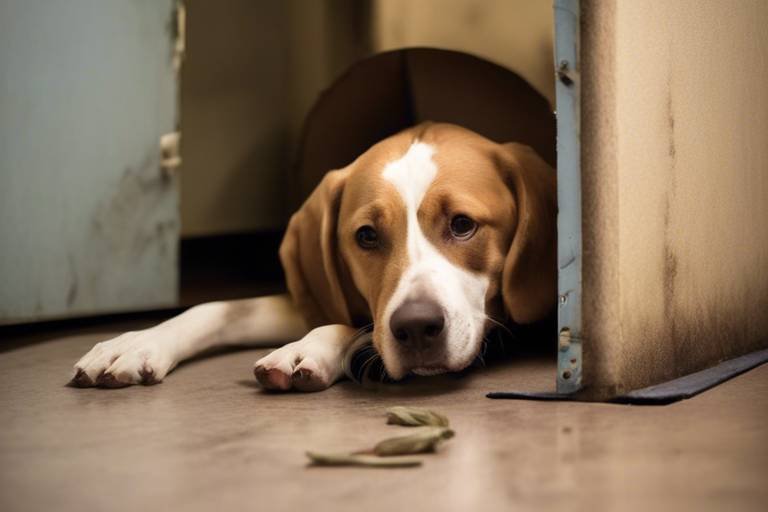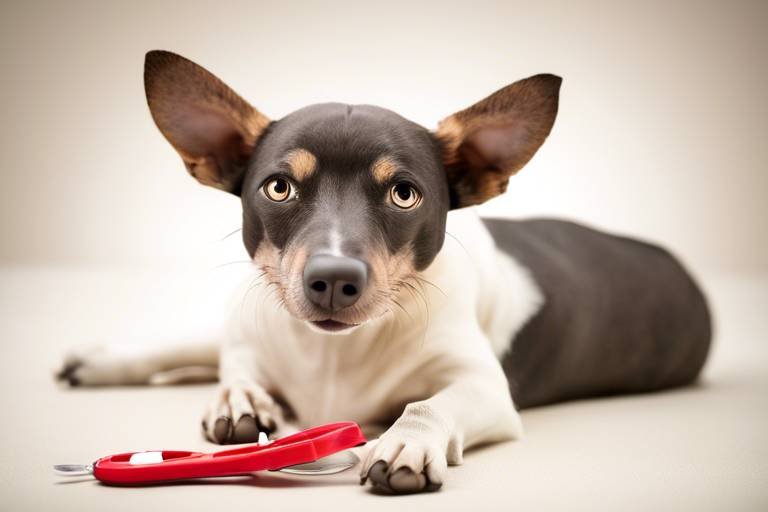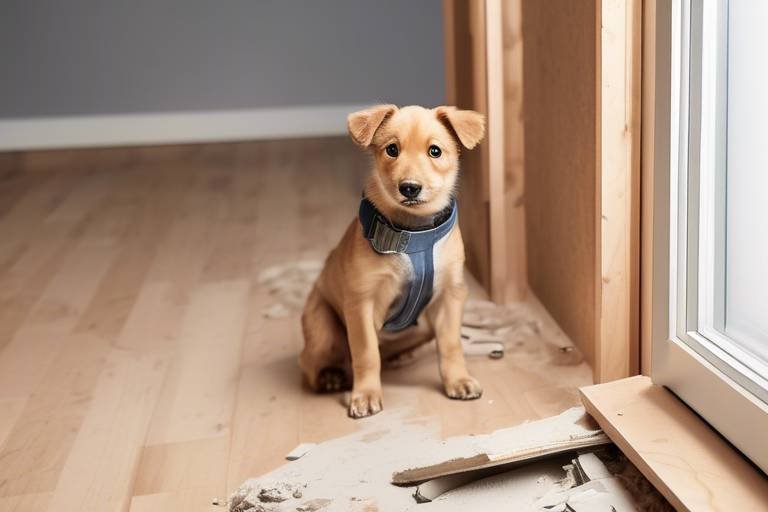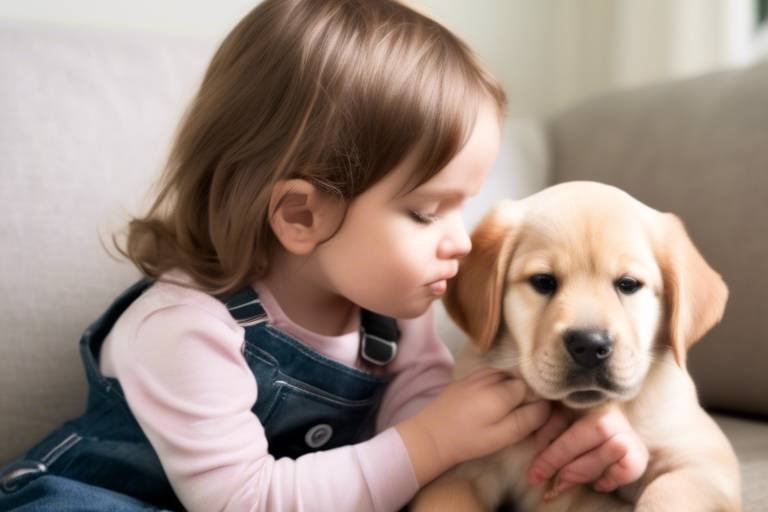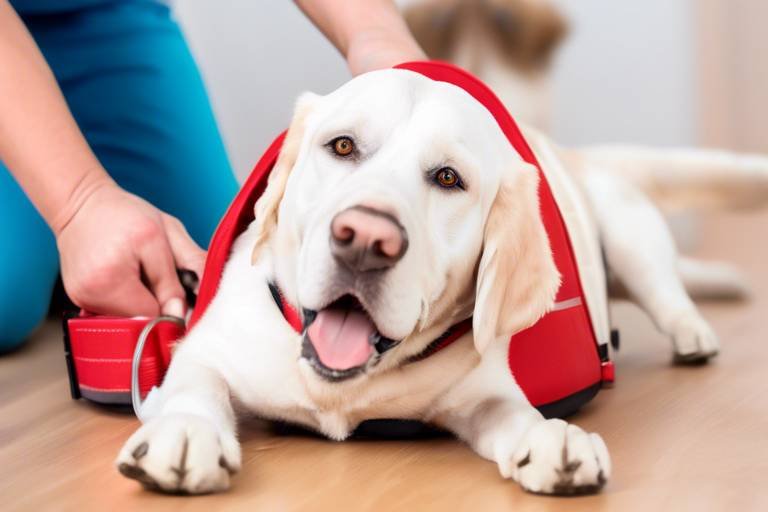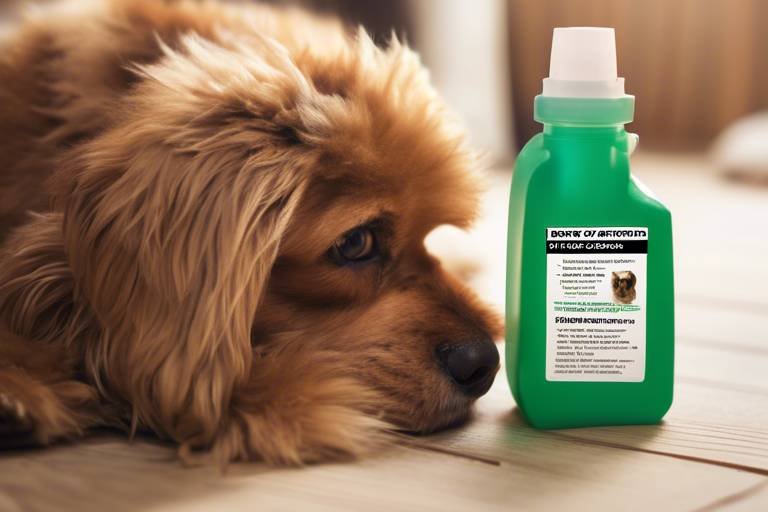The Importance of Pet Emergency Plans
When it comes to our furry friends, their safety is often at the forefront of our minds. But have you ever thought about what would happen in an emergency? Just like we prepare for unexpected situations in our lives, it's crucial to have a pet emergency plan in place. This plan isn't just a nice-to-have; it's a necessity that can make a world of difference when disaster strikes. From natural disasters like hurricanes and floods to sudden accidents, having a well-thought-out strategy ensures that our pets remain safe and secure, no matter the circumstances.
Imagine this: a sudden storm rolls in, and the winds are howling outside your window. You’re worried about your home, but what about your pet? Do you have a plan for them? This is where a pet emergency plan comes into play. It serves as a roadmap for both you and your pet, detailing the necessary steps to take in various emergencies. With a solid plan, you can reduce panic and confusion, allowing you to focus on what truly matters—keeping your beloved companion safe.
Moreover, having an emergency plan can significantly reduce the stress levels for both you and your pet. Pets can sense anxiety, and if you’re frazzled, they likely will be too. A clear plan helps to create a sense of security, ensuring that your furry family member knows what to expect. In a world where unpredictability is the only constant, being prepared is your best defense. So, let’s dive deeper into what a pet emergency plan entails and how you can craft one that works for you and your pet.
In the following sections, we will explore various aspects of pet emergency plans, from creating an emergency kit to training your pet for unexpected situations. By the end of this article, you’ll be equipped with the knowledge to ensure your pet's safety during any crisis. Remember, it’s not just about having a plan; it’s about making sure it’s effective and easy to follow when it matters most.
- What is a pet emergency plan? A pet emergency plan is a comprehensive strategy that outlines the steps to take to ensure the safety and well-being of your pet during emergencies.
- Why do I need a pet emergency kit? An emergency kit contains essential supplies that can help you care for your pet during unforeseen circumstances, ensuring their comfort and safety.
- How can I train my pet for emergencies? Training involves teaching your pet basic commands and desensitizing them to stressful situations, which can help them remain calm during emergencies.

Understanding Pet Emergency Plans
When it comes to our furry friends, we often think of them as family. Just like we prepare for unforeseen circumstances in our own lives, it's crucial to have a solid pet emergency plan in place. This plan acts as a roadmap, guiding you through the necessary steps to ensure your pet's safety during a crisis. Whether it’s a natural disaster like a hurricane or an unexpected accident, having a plan can make all the difference.
A well-thought-out emergency plan covers various aspects, from preparation strategies to resources and protocols. It’s not just about reacting when something happens; it’s about being proactive. Imagine the peace of mind that comes with knowing you have everything sorted out ahead of time. You wouldn't drive a car without a seatbelt, right? Similarly, you shouldn't navigate emergencies without a plan for your pets.
In essence, your pet emergency plan should include:
- Emergency contacts: Keep a list of veterinarians, animal shelters, and pet-friendly hotels handy.
- Evacuation routes: Know the safest routes to take in case you need to leave your home quickly.
- Emergency supplies: Have a kit ready that includes food, water, medications, and comfort items.
Moreover, it’s essential to regularly review and update your plan. Life changes, and so do your pets’ needs. For instance, if you adopt a new pet or if your current pet develops a medical condition, your plan should reflect those changes. Think of your pet emergency plan as a living document—one that evolves with your circumstances.
Lastly, don't forget to involve your family in this planning process. Everyone should know the plan and their specific roles. After all, in a high-stress situation, clear communication is key. By working together, you can ensure that your beloved pets receive the care they need, no matter what life throws your way.

Creating a Pet Emergency Kit
When it comes to ensuring the safety and well-being of your furry family members during emergencies, creating a Pet Emergency Kit is absolutely essential. Think of it as a lifeline that will help you navigate through unexpected situations like natural disasters, accidents, or even sudden health issues. Just like you wouldn't head out on a road trip without snacks and a spare tire, you shouldn't be caught off guard without a well-stocked emergency kit for your pets. So, what should you include in this all-important kit? Let's dive in!
First and foremost, you need to consider the basic necessities: food and water. It's crucial to have at least a few days' worth of both. For food, opt for high-quality, non-perishable options that your pet is accustomed to. You wouldn’t want to introduce a new diet during a stressful time! As for water, a good rule of thumb is to have one gallon per pet per day, stored in sturdy containers. This ensures that your pets stay hydrated, even in the most challenging circumstances.
Next up, medications and health supplies. If your pet is on any medication, make sure to have a supply that lasts at least a week. This is especially important for pets with chronic conditions. Additionally, a basic first aid kit tailored for pets can be a lifesaver. It should include items like gauze, antiseptic wipes, tweezers, and even a digital thermometer. You can find pre-made kits at pet stores, or you can assemble one yourself. Remember, it’s not just about having the supplies; knowing how to use them is equally important, so familiarize yourself with basic pet first aid techniques.
Another vital component of your kit is identification and documentation. Imagine the panic of losing your pet during an evacuation! To prevent that, make sure your pet has a collar with an ID tag that includes your contact information. Microchipping is also highly recommended as it provides a permanent form of identification. In addition, keep a copy of your pet's medical records, vaccination history, and any important documents in a waterproof bag within your kit. This way, you can easily provide the necessary information to a vet if needed.
Comfort items can also make a world of difference in keeping your pet calm during stressful situations. Include their favorite blanket, toys, or even a piece of your clothing. These familiar scents can provide comfort and help alleviate anxiety. It’s like having a little piece of home with them, which can be incredibly reassuring in times of uncertainty.
Lastly, don't forget about leashes and carriers. Depending on your pet's size and temperament, having a sturdy leash and a comfortable carrier can make evacuations smoother. Practice getting your pet into the carrier calmly and efficiently, so they’re familiar with the process. A little bit of practice can go a long way in ensuring that both you and your pet remain composed during an emergency.
In summary, creating a Pet Emergency Kit is not just a good idea; it's a necessity. By being proactive and preparing for the unexpected, you’re not only safeguarding your pets but also giving yourself peace of mind. Remember, the goal is to be ready for anything that comes your way. So, gather your supplies, keep them organized, and make sure everyone in your household knows where the kit is stored. After all, when disaster strikes, every second counts!
Essential Supplies for Your Kit
When it comes to ensuring your pet's safety during emergencies, having a well-stocked emergency kit is absolutely vital. Think of this kit as a lifeline for your furry friend when the unexpected strikes. You wouldn’t head out on a road trip without snacks and a spare tire, right? The same logic applies here! Your pet deserves the same level of preparation. So, what exactly should you include in this essential kit? Let’s break it down.
First and foremost, food and water are non-negotiable. You’ll want to pack enough food to last at least a week, considering your pet's dietary needs. It’s a good idea to store this food in airtight containers to keep it fresh. For water, aim for at least one gallon per pet per day. This ensures your pet stays hydrated, even in the most stressful situations. Remember, if your pet is on any medications, include a supply of those as well. It’s crucial to keep their health on track during emergencies.
Next up, let’s talk about comfort and safety. Pets can get anxious during chaotic situations, so including familiar items can help soothe their nerves. Think about packing:
- Leashes and Collars: Make sure they are sturdy and fit well.
- First Aid Kit: Include bandages, antiseptic wipes, and any specific items your pet may need.
- Comfort Items: A favorite blanket or toy can provide a sense of security.
Additionally, don’t forget to include identification and documentation. Microchipping your pet is one of the best ways to ensure they can be returned to you if lost. However, it’s also wise to have physical ID tags attached to their collar. In your kit, keep a copy of their vaccination records and any other important documents. This can be a lifesaver if you need to board your pet or seek veterinary assistance in an unfamiliar area.
Lastly, consider including a portable pet carrier. This can be invaluable for transportation during an evacuation. Choose one that is comfortable for your pet and easy for you to carry. Remember, the goal here is to create a kit that not only meets your pet's basic needs but also provides emotional support during a time of crisis.
In summary, having the right supplies in your pet emergency kit can make a world of difference. It’s all about being proactive and ensuring that you’re prepared for whatever may come your way. After all, when it comes to our pets, we want to be their heroes in times of distress!
Q1: How often should I check my pet emergency kit?
A1: It’s a good idea to check your kit every six months to ensure that food, medications, and other supplies are still fresh and in good condition.
Q2: Can I use regular human food in my pet emergency kit?
A2: While some human foods are safe for pets, it’s best to stick with pet-specific food to ensure they get the proper nutrition.
Q3: What should I do if my pet has special medical needs?
A3: If your pet has specific medical requirements, make sure to include all necessary medications and consult your vet for additional advice on emergency preparedness.
Food and Water Considerations
When it comes to ensuring your pet's safety during an emergency, proper nutrition and hydration are absolutely crucial. Imagine being in a stressful situation—whether it’s a natural disaster or an unexpected evacuation. The last thing you want to worry about is whether your furry friend has enough food and water to stay healthy and calm. Therefore, planning ahead is key!
First off, you need to consider how much food and water your pet will need. A general rule of thumb is to have at least a three-day supply of food and water for each pet. This means if you have a dog that eats about 2 cups of food a day, you should store at least 6 cups of dry food in your emergency kit. For water, aim for about 1 ounce of water per pound of body weight each day. So, if your dog weighs 50 pounds, you would need at least 150 ounces of water—approximately 1.2 gallons!
| Pet Type | Daily Food Requirement | Daily Water Requirement |
|---|---|---|
| Small Dog (up to 20 lbs) | 1-2 cups | 8-12 ounces |
| Medium Dog (20-50 lbs) | 2-3 cups | 12-24 ounces |
| Large Dog (50+ lbs) | 3-4 cups | 24-32 ounces |
| Cat | 1-2 cups | 8-12 ounces |
Choosing the right types of food is also important. Opt for high-quality pet food that your pet is already accustomed to. If you switch to a different brand in an emergency, it could upset their stomach, leading to further complications. Don't forget to consider any special dietary needs your pet may have. If your pet requires a specific type of food due to allergies or health conditions, make sure to stockpile that as well.
Water storage is another factor that should not be overlooked. Use clean, sealed containers to store your water, and remember to rotate it every six months to ensure freshness. In addition, consider adding a portable water bowl in your emergency kit. This way, you can easily provide water to your pet no matter where you are.
In summary, keeping your pet well-fed and hydrated during emergencies is not just a matter of convenience; it’s a matter of their health and well-being. By planning ahead and ensuring you have enough food and water, you can significantly reduce stress for both you and your pet in those critical moments. After all, a well-prepared pet owner is a happy pet owner!
- How much food should I store for my pet? Aim for at least a three-day supply based on your pet's daily consumption.
- Can I use tap water for my pet's emergency supply? Yes, but make sure to store it in clean, sealed containers and rotate it every six months.
- What if my pet has special dietary needs? Always prioritize their specific food requirements when preparing your emergency kit.
Identification and Documentation
When it comes to ensuring your pet's safety during emergencies, are absolutely critical. Imagine a situation where you and your furry friend are separated during a chaotic evacuation. The heart-wrenching thought of losing them can be overwhelming. This is why having the right identification methods in place is not just a good idea; it's essential.
First off, consider microchipping. This tiny chip, implanted just under your pet's skin, can be a lifesaver. If your pet gets lost, shelters and veterinary clinics equipped with microchip scanners can quickly identify your pet and reunite you. It's a simple procedure that can offer peace of mind in unpredictable situations.
In addition to microchipping, make sure your pet wears a collar with a sturdy ID tag. This tag should include your pet's name, your contact number, and any relevant medical information. Think of it as a mini-resume for your pet! If someone finds them, they can easily reach out to you. However, collars can come off, so having multiple forms of identification is wise.
Don't forget about keeping your pet's health documentation organized and accessible. This includes vaccination records, medical history, and any special needs your pet may have. In an emergency, veterinary clinics may require this information to provide the best care possible. Consider keeping these documents in a waterproof folder in your emergency kit. This way, you can grab it quickly if you need to leave in a hurry.
Lastly, it’s a good idea to take recent photos of your pet from different angles. This can be incredibly helpful in case they go missing. You can share these photos on social media or with local shelters to increase the chances of a reunion. Remember, a picture is worth a thousand words, and in this case, it could be worth your pet's safe return!
In summary, having a comprehensive identification and documentation plan is a key component of your pet emergency plan. By taking these simple yet effective steps, you can significantly increase the likelihood of being reunited with your beloved pet, even in the most chaotic of circumstances.
- What should I do if my pet gets lost during an emergency?
Immediately contact local shelters and veterinary clinics, and share your pet's recent photos and description on social media. - How often should I update my pet's identification tags?
It's best to update them whenever there is a change in your contact information or if you move to a new location. - Is microchipping painful for my pet?
No, microchipping is a quick and relatively painless procedure, similar to getting a vaccination. - What documents should I keep for my pet?
Keep vaccination records, medical history, and any special care instructions in a waterproof folder.
Planning for Evacuations
When disaster strikes, the last thing you want is to be scrambling for a plan. with your pets is not just a wise move; it’s a necessity. Think of it like a fire drill at school, but instead, you’re ensuring that your furry family members are just as prepared as you are. The first step in creating a solid evacuation plan is to identify safe destinations. This could be a friend’s house, a pet-friendly hotel, or even a local shelter. Knowing where you can go will save you precious time during a crisis.
Next up, transportation. Do you have a reliable way to transport your pets? Whether it’s a sturdy pet carrier or a leash for your dog, having the right equipment is crucial. Imagine trying to stuff a panicking cat into a carrier when you’re already stressed out! To avoid this chaos, make sure your pet is comfortable with their carrier ahead of time. You can even leave it out in your home as a safe space for them to explore and get used to.
Another important aspect of your evacuation plan is to prepare your pets for travel. This includes getting them accustomed to being in a car or a carrier for extended periods. Consider taking short trips with them, gradually increasing the duration. This will help them adjust and reduce anxiety when the real evacuation happens. Remember, a calm pet makes for a smoother journey.
Don't forget to pack a pet emergency kit that travels with you. This kit should include essentials like food, water, medications, and comfort items. It’s like packing a suitcase for a vacation, but instead, you’re ensuring your pet has everything they need during an evacuation. Here’s a quick table to summarize what to include in your pet emergency kit:
| Item | Purpose |
|---|---|
| Food | To keep your pet nourished |
| Water | To ensure hydration |
| Medications | To maintain health during emergencies |
| Leash and Carrier | To safely transport your pet |
| ID Tags | To help locate your pet if lost |
Lastly, keep your pets’ identification and documentation handy. This includes microchip information, vaccination records, and any other important documents. In the chaos of an evacuation, having these documents on hand can make a world of difference in reuniting you with your pet if you get separated. Think of it as your pet’s passport for emergencies!
In conclusion, planning for evacuations isn’t just about having a plan; it’s about ensuring the safety and well-being of your beloved pets. By preparing in advance, you can turn a potentially chaotic situation into a manageable one, keeping both you and your furry companions calm and collected.
Q: What should I do if I can't evacuate with my pet?
A: If you cannot evacuate with your pet, try to find a trusted friend or family member who can take care of them. Make sure they are aware of your pet's needs and have access to your emergency kit.
Q: How can I help my pet cope during an evacuation?
A: Familiarize your pet with their carrier or travel gear beforehand. Bring comfort items like their favorite blanket or toy to help them feel secure.
Q: What if my pet is scared of loud noises during an evacuation?
A: Gradually expose your pet to loud sounds in a controlled environment. Use treats and positive reinforcement to create a positive association with the noise.

Training Your Pets for Emergencies
When it comes to emergencies, training your pets can be the difference between chaos and calm. Imagine a scenario where a sudden storm hits, or an unexpected evacuation is ordered. In these moments, having a well-prepared pet can make all the difference. Training your pets to respond appropriately during emergencies not only enhances their safety but also ensures your peace of mind. Just like teaching a child to swim can save their life, teaching your furry friends how to behave in a crisis is equally vital.
One of the most effective ways to prepare your pets is by familiarizing them with basic commands. These commands can help guide your pet through stressful situations, making it easier for you to manage their behavior. Think of it as giving your pet a “roadmap” to follow when they’re feeling anxious. Commands like “come,” “stay,” and “leave it” are essential for maintaining control. If you can get your pet to obey these commands, you can navigate through emergencies with greater ease.
But it’s not just about commands; it’s also about desensitization. Desensitization techniques can help your pets cope with the unusual sounds and sights they might encounter during a crisis. For example, if your pet is scared of thunder, you can gradually expose them to loud noises in a controlled environment, rewarding calm behavior with treats and praise. This technique is akin to taking baby steps toward a bigger goal. Over time, your pet will learn that these noises are not threats, thereby reducing their anxiety.
Moreover, it’s crucial to practice evacuation drills with your pets. Just as schools conduct fire drills, having a practice run with your pets can prepare them for real-life situations. This could include getting them used to being placed in carriers or getting them accustomed to the sound of a leash being clipped. By repeating these actions, your pet will become more comfortable and responsive when it really matters. Remember, consistency is key—the more you practice, the more natural it will feel for both you and your pet.
Lastly, don’t forget to include your pets in family discussions about emergency plans. This not only helps them understand what’s happening but also reinforces their training. For instance, you can explain why certain behaviors are important during an emergency, making them more likely to comply. Think of it as a team effort; when everyone is on the same page, the chances of a successful outcome increase significantly.
Here are some common questions pet owners have regarding training their pets for emergencies:
| Question | Answer |
|---|---|
| How can I start training my pet for emergencies? | Begin with basic commands and gradually introduce desensitization techniques to help them cope with stress. |
| What commands should I focus on? | Focus on commands like “come,” “stay,” and “leave it” to help manage your pet during emergencies. |
| How often should I practice evacuation drills? | Practice evacuation drills regularly, ideally once a month, to keep your pet familiar with the process. |
| Is desensitization effective for all pets? | Yes, most pets can benefit from desensitization, but the approach may vary based on their individual temperament. |
Basic Commands to Teach
When it comes to ensuring your pet's safety during emergencies, teaching them basic commands is essential. These commands not only help in managing your pet in stressful situations but also enhance the bond between you and your furry friend. Imagine being in a chaotic environment, and your pet responds to your commands as if they were trained for this moment. It’s a game-changer! Here are a few fundamental commands you should focus on:
1. Come: This command is crucial. In an emergency, calling your pet to you could prevent them from running into danger. Start by calling your pet in a calm voice and rewarding them with treats when they come to you. Consistent practice in various environments will help them understand that this command is important, no matter where they are.
2. Sit: Teaching your pet to sit on command can be particularly useful when you need them to stay put, especially in crowded or chaotic situations. It’s a simple command that can keep your pet safe while you assess the situation. Use treats and positive reinforcement to encourage them to sit when asked.
3. Stay: The stay command is vital for keeping your pet in a safe spot while you handle an emergency. Start by asking your pet to sit, then gradually increase the distance between you and your pet while saying "stay." Reward them for staying in place, and practice this regularly to build their confidence.
4. Leave it: This command can save your pet's life. Whether it’s a dangerous object or food that could harm them, teaching them to leave it on command can prevent accidents. Use a treat to teach them what "leave it" means, gradually introducing distractions to ensure they understand the command in various scenarios.
5. Down: The down command can help your pet stay low and calm during emergencies. It can also be a great way to keep them out of the way. Training your pet to lie down when asked can be an effective way to manage their behavior in stressful situations.
Beyond these commands, it's also beneficial to incorporate desensitization techniques. This means exposing your pet to various sounds and situations that may occur during emergencies, such as loud noises or crowds. By gradually introducing these elements, you can help reduce their anxiety and promote calm behavior.
Remember, consistency is key. Regular training sessions, combined with positive reinforcement, will help your pet become more responsive to these commands. You want them to associate these commands with safety and reassurance, especially during times of uncertainty. So, grab those treats and start training—your pet's safety depends on it!
- Why are basic commands important for pets during emergencies? Basic commands help manage your pet's behavior, keeping them safe and calm in stressful situations.
- How often should I train my pet on these commands? Regular training sessions, ideally a few times a week, will reinforce these commands and ensure your pet responds reliably.
- Can all pets learn these commands? Yes! Most pets can learn basic commands with patience and consistent training, regardless of age or breed.
Desensitization Techniques
When it comes to preparing our furry companions for emergencies, play a pivotal role. Just like how we might acclimate ourselves to a new environment, pets also need time and guidance to adjust to potentially frightening situations. Imagine your pet as a sponge; they soak up experiences, both good and bad. By gradually introducing them to various stressors, we can help them become more resilient and less anxious during emergencies.
One effective method is to expose your pet to various sounds that they might encounter during a crisis. For example, you can play recordings of thunder, sirens, or even loud crowds at a low volume. Start with the sound at a minimal level and gradually increase the volume as your pet becomes more comfortable. This slow exposure allows them to associate these sounds with positive experiences, such as treats or playtime, rather than fear.
Another technique is to simulate emergency situations in a controlled environment. For instance, you could practice evacuation drills with your pet. Start by walking them through the steps of your emergency plan, ensuring they know where to go and what to do. Make it a fun exercise! Use treats and praise to reinforce their positive behavior during these drills. Over time, this will help them understand that these actions are part of a routine rather than a cause for alarm.
It’s also essential to create a safe space for your pet where they can retreat when feeling overwhelmed. This could be a cozy corner with their favorite blanket or a designated room where they feel secure. Encourage them to spend time in this space during practice sessions, so they learn to associate it with comfort and safety.
Lastly, consider using calming products such as pheromone diffusers or anxiety wraps. These can provide additional support during the desensitization process, making it easier for your pet to cope with stress. Remember, the goal is to create a positive and reassuring environment for your pet, helping them to understand that they are safe, even when faced with unexpected challenges.
In conclusion, desensitization techniques are not just about exposing pets to stressors; they are about building a foundation of trust, safety, and resilience. By taking the time to prepare our pets through these methods, we can help ensure their well-being during emergencies, making the experience less daunting for both them and us.
- What is desensitization? Desensitization is the process of gradually exposing pets to stressors to reduce their anxiety and fear responses.
- How long does desensitization take? The time it takes varies by pet. Some may adapt quickly, while others may need weeks of gradual exposure.
- Can all pets be desensitized? Yes, most pets can benefit from desensitization techniques, but the approach may differ based on their individual personalities and past experiences.
- What should I do if my pet shows extreme fear during desensitization? If your pet displays significant fear, it's essential to stop the exposure and consult a professional trainer or veterinarian for guidance.

Staying Informed and Prepared
When it comes to the safety of our beloved pets, being informed and prepared is not just a good idea; it's a necessity. Emergencies can strike at any time, and knowing how to respond can make all the difference. So, what can you do to stay ahead of the curve? First and foremost, it's essential to monitor local emergency alerts. This means keeping an eye on weather updates, community alerts, and any other information that could impact your area. For instance, if you live in a region prone to hurricanes or wildfires, knowing when to evacuate or prepare in advance can save lives.
Additionally, understanding the specific risks in your area is crucial. Each location has its unique set of challenges, whether it’s flooding, earthquakes, or severe storms. Take a moment to research what types of emergencies are most likely to occur in your locality. This knowledge will allow you to tailor your pet emergency plan accordingly. For example, if you live in a flood-prone area, ensure your emergency kit includes items that can withstand water damage.
Another vital aspect of staying informed is establishing a communication plan. In the chaos of an emergency, it's easy to lose track of family members and pets. Create a plan that includes:
- Designated meeting spots
- Emergency contact numbers
- Local shelters that accept pets
By having a clear communication strategy, you can ensure everyone knows where to go and who to contact in case of an emergency. And don't forget to share this plan with anyone who may be responsible for your pets in your absence, such as friends, family, or pet sitters.
Finally, consider joining local pet-focused organizations or online communities. These platforms can provide valuable resources, tips, and updates about local emergencies that could affect pet safety. Connecting with other pet owners can also offer peace of mind and shared strategies for keeping your furry friends safe.
- What should I include in my pet emergency kit?
Your pet emergency kit should include food, water, medications, a leash, a first aid kit, comfort items, and identification documents.
- How can I keep my pet calm during an emergency?
Train your pet with basic commands and use desensitization techniques to help them cope with stress during emergencies.
- What should I do if I have to evacuate with my pet?
Plan your evacuation route in advance, ensure you have your emergency kit ready, and know which shelters accept pets.
Frequently Asked Questions
-
What is a pet emergency plan?
A pet emergency plan is a comprehensive strategy that outlines the steps you need to take to ensure your pet's safety during unforeseen events, such as natural disasters or accidents. It includes preparation tips, necessary resources, and protocols to follow when a crisis occurs.
-
What should I include in my pet emergency kit?
Your pet emergency kit should contain essential items like food, water, medications, a first aid kit, leashes, and comfort items like toys or blankets. Having these supplies readily available can make a significant difference in your pet’s well-being during emergencies.
-
How much food and water should I store for my pet?
It's generally recommended to have at least a three-day supply of food and water for your pet. Consider your pet's size and dietary needs when determining the amount, and remember to rotate supplies regularly to keep them fresh.
-
Why is pet identification important in emergencies?
Identification is crucial because it increases the chances of reuniting with your pet if they get lost during an emergency. Microchipping, having ID tags, and keeping relevant health documents handy can make a world of difference in stressful situations.
-
How can I prepare my pet for an evacuation?
Preparing for an evacuation involves creating a detailed plan that includes transportation options and safe destinations for your pets. Familiarizing your pets with carriers and practicing getting them into the vehicle can help reduce stress during an actual evacuation.
-
What basic commands should I teach my pet for emergencies?
Teaching basic commands like "come," "stay," and "leave it" can significantly aid in emergency situations. These commands can help you maintain control over your pet and facilitate safe evacuations.
-
What are desensitization techniques for pets?
Desensitization techniques involve gradually exposing your pet to unusual sounds or situations they might encounter during emergencies. This process helps reduce anxiety and promotes calm behavior, making it easier for them to cope when the unexpected happens.
-
How can I stay informed about local emergencies?
Staying informed involves regularly monitoring local emergency alerts, weather forecasts, and understanding the specific risks in your area. This knowledge allows you to prepare adequately and take proactive measures to protect your pets.









